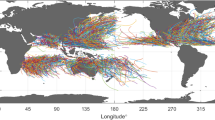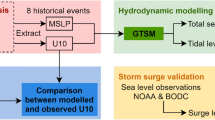Abstract
Advances in the study of tropical cyclones using aircraft observations came about through improvements (scientific and technological) in the ability to observe different aspects of the storms. Early studies provided the basis for understanding tropical cyclone structure and evolution (for an excellent overview see Dorst, 2007). Technological advances in aircraft in-situ and remote sensing observing capabilities, particularly the development of airborne Doppler radars, revolutionized our depiction of tropical cyclone structure and dynamics (for a review see Marks, 2003).
Access this chapter
Tax calculation will be finalised at checkout
Purchases are for personal use only
Preview
Unable to display preview. Download preview PDF.
Similar content being viewed by others
References
Aberson, S.D. (2003). Targeted observations to improve operational tropical cyclone track forecast guidance. Mon. Wea. Rev., 131: 1613-1628.
Aberson, S.D., Black, M.L., Black, R.A., Burpee, R.W., Cione, J.J., Landsea, C.W. and Marks, F.D. (2006). Twenty-five years of tropical cyclone research with the NOAA P-3 aircraft. Bull. Amer. Meteor. Soc., 87: 1039-1055, doi: http://dx.doi.org/10.1175/BAMS-87-8-1039.
Aksoy, A., Lorsolo, S., Vukicevic, T., Sellwood, K.J., Aberson, S.D. and Zhang, F. (2012). The HWRF Hurricane Ensemble Data Assimilation System (HEDAS) for high-resolution data: The impact of airborne Doppler radar observations in an OSSE. Mon. Wea. Rev., 140: doi: http://dx.doi.org/10.1175/MWR-D-11-00212.1
Barnes, G.M., Zipser, E.J., Jorgensen, D.P. and Marks, F.D. (1983). Mesoscale and convective structure of a hurricane rainband. J. Atmos. Sci., 40: 2125-2137.
Barnes, G.M., Gamache, J.F., LeMone, M.A. and Stossmeister, G.J. (1991). A convective cell in a hurricane rainband. Mon. Wea. Rev., 119: 776-794.
Barnes, G.M. and Powell, M.D. (1995). Evolution of the inflow boundary layer of Hurricane Gilbert (1988). Mon. Wea. Rev., 123: 2348-2368.
Black, P.G. (1983). Ocean temperature changes induced by tropical cyclones. Ph.D. thesis, The Pennsylvania State University.
Black, P.G., Elsberry, R.L., Shay, L.K., Partridge, R.P. and Hawkins, J.F. (1988). Atmospheric and oceanic mixed layer observations in Hurricane Josephine obtained from air-deployed drifting buoys and research aircraft. J. Atmos. Oceanic Technol., 5: 683-698.
Black, P.G. and Holland, G.J. (1995). The Boundary Layer of Tropical Cyclone Kerry (1979). Mon. Wea. Rev., 123: 2007-2028.
Black, P.G. et al. (2007). Air-sea exchange in hurricanes: Synthesis of observations from the coupled boundary layer air-sea transfer experiment. Bull. Amer. Meteor. Soc., 88: 357-374.
Black, R.A. and Hallett, J. (1986). Observations of the distribution of ice in hurricanes. J. Atmos. Sci., 43: 802-822.
Burpee, Robert W. et al. (1994). Real-Time Guidance Provided by NOAA’s Hurricane Research Division to Forecasters during Emily of 1993. Bull. Amer. Meteor. Soc., 75: 1765-1783.
Burpee, R.W., Franklin, J.L., Lord, S.J., Tuleya, R.E. and Aberson, S.D. (1996). The impact of Omega dropwindsondes on operational hurricane track forecast models. Bull. Amer. Meteor. Soc., 77: 925-933.
Cione, J.J. and Uhlhorn, E.W. (2003). Sea surface temperature variability in hurricanes: Implications with respect to intensity change. Mon. Wea. Rev., 131: 1783-1796.
Cione, J.J., Black, P.G. and Houston, S.H. (2000). Surface observations in the hurricane environment. Mon. Wea. Rev., 128: 1550-1561.
D’Asaro, E.A. (2003). Performance of autonomous Lagrangian floats. J. Atmos. Oceanic Technol., 20: 896-911.
Davis, W. R. (1954). Hurricanes of 1954. Mon. Wea. Rev., 82: 370-373.
Dorst, N.M. (2007). The National Hurricane Research Project: 50 years of research, rough rides, and name changes. Bull. Amer. Meteor. Soc., 88: 1566-1588, doi: http://dx.doi.org/10.1175/BAMS-88-10-1566.
Franklin, J.L., Feuer, S.E., Kaplan, J. and Aberson, S.D. (1996). Tropical cyclone motion and surrounding flow relationships: Searching for beta gyres in omega dropwindsonde data sets. Mon. Wea. Rev., 124: 64-84.
Franklin, J.L., Black, M.L. and Valde, K. (2003). GPS dropwindsonde wind profiles in hurricanes and their operational implications. Wea. Forecasting, 18: 32-44.
Gall, R., Franklin, J., Marks, F.D., Rappaport, E.N. and Toepfer, F. (2012). The Hurricane Forecast Improvement Project. Bull. Amer. Meteor. Soc. (accepted).
Gamache, J.F., Houze Jr., R.A. and Marks Jr., F.D. (1993). Dual-aircraft investigation of the inner core of Hurricane Norbert. Part III: Water budget. J. Atmos. Sci., 50: 3221-3243.
Gentry, R.C. (1981). History of hurricane research in the United States with special emphasis on the National Hurricane Research Laboratory and associated groups. Preprints, 13th Technical Conf. on Hurricanes and Tropical Meteorology, Miami Beach, FL. Amer. Meteor. Soc.
Gopalakrishnan, S., Marks, F.D., Zhang, J., Zhang, X., Bao, J.-W. and Tallapragada, V. (2012). A study of the impact of vertical diffusion on the structure and intensity of tropical cyclones using the high-resolution HWRF system. J. Atmos. Sci. (accepted).
Govind, P.K. (1975). Dropwindsonde instrumentation for weather reconnaissance aircraft. J. Appl. Meteor., 14: 1512-1520.
Griffin, J.S., Burpee, R.W., Marks, F.D. and Franklin, J.L. (1992). Real-Time Airborne Analysis of Aircraft Data Supporting Operational Hurricane Forecasting. Wea. Forecasting, 7: 480-490.
Hock, T.F. and Franklin, J.L. (1999). The NCAR GPS Dropwindsonde. Bull. Amer. Meteor. Soc., 80: 407-420.
Houze, R.A., Marks Jr., F.D. and Black, R.A. (1992). Dual-aircraft investigation of the inner core of Hurricane Norbert. Part II: Mesoscale distribution of ice particles. J. Atmos. Sci., 49: 943-963.
Ishihara, M., Yanagisawa, Z., Sakakibara, H., Matsuura, K. and Aoyagi, J. (1986). Structure of typhoon rainband observed by two Doppler radars. J. Met. Soc. Japan, 64: 923-939.
Jaimes, B. and Shay, L.K. (2009). Mixed layer cooling in mesoscale oceanic eddies during Hurricanes Katrina and Rita. Mon. Wea. Rev., 137: 4188-4207.
Jelesnianski, C.P., Chen, J. and Shaffer, W.A. (1992). SLOSH: Sea, lake and overland surges from hurricanes. NOAA Tech. Rep. NWS 48, Silver Spring, MD.
Jorgensen, D.F. (1984a). Mesoscale and Convective-Scale Characteristics of Mature Hurricanes. Part I: General Observations by Research Aircraft. J. Atmos. Sci., 41: 1268-1286.
Jorgensen, D.F. (1984b). Mesoscale and convective-scale characteristics of mature hurricanes. Part II: Inner core structure of Hurricane Allen (1980). J. Atmos. Sci., 41: 1287-1311.
Jorgensen, D.F., Hildebrand, P.H. and Frush, C.L. (1983). Feasibility test of an airborne pulse-Doppler meteorological radar. J. Climate Appl. Meteor., 22: 744-757.
Malmquist, D.L. and Michaels, A.F. (2000). Severe storms and the insurance industry. Storms, Vol. I, Pielke Jr., R.A. and Pielke Sr., R.A. (eds), Routledge Press.
Marks, F.D. (2003). State of the Science: Radar View of Tropical Cyclones. In: Radar and Atmospheric Science: A Collection of Essays in Honor of David Atlas. (Eds) R.M Wakimoto and R.C. Srivastava. Meteorological Monographs, 52: 33-74, AMS, Boston, MA.
Marks, F.D. and Houze, R.A. (1984). Airborne Doppler Radar Observations in Hurricane Debby. Bull. Amer. Meteor. Soc., 65: 569-582.
Marks, F.D. and Houze, R.A. (1987). Inner core structure of Hurricane Alicia from airborne Doppler radar observations. J. Atmos. Sci., 44: 1296-1317.
Marks, F.D., Houze Jr., R.A. and Gamache, J.F. (1992). Dual-aircraft investigation of the inner core of Hurricane Norbert. Part I: Kinematic structure. J. Atmos. Sci., 49: 919-942.
Marks, F.D. and Shay, L.K. (1998). Landfalling Tropical Cyclones: Forecast Problems and Associated Research Opportunities. Bull. Amer. Meteor. Soc., 79: 305-323.
Moller, J.D. and Montgomery, M.T. (1999). Vortex Rossby waves and hurricane intensification in a barotropic model. J. Atmos. Sci., 56: 1674-1687.
Moller, J.D. and Montgomery, M.T. (2000). Tropical cyclone evolution via potential vorticity anomalies in a three-dimensional balance model. J. Atmos. Sci., 57: 3366- 3387.
Montgomery, M.T. and Kallenbach, R. (1997). A theory for vortex Rossby-waves and its application to spiral bands and intensity changes in hurricanes. Quart. J. Roy. Meteor. Soc., 123: 435-465.
Montgomery, M.T. et al. (2012). The Pre-Depression Investigation of Cloud-Systems in the Tropics (PREDICT) Experiment: Scientific Basis, New Analysis Tools, and Some First Results. Bull. Amer. Meteor. Soc., 93: 153-172, doi: http://dx.doi.org/10.1175/BAMS-D-11-00046.1
Nystuen, J.A. and Selsor, H.D. (1997). Weather classification using passive acoustic drifters. J. Atmos. Oceanic Technol., 14: 656-666.
Powell, M.D. (1990a). Boundary layer structure and dynamics in outer hurricane rainbands. Part I: Mesoscale rainfall and kinematic structure. Mon. Wea. Rev., 118: 891-917.
Powell, M.D. (1990b). Boundary layer structure and dynamics in outer hurricane rainbands. Part II: Downdraft modification and mixed layer recovery. Mon. Wea. Rev., 118: 918-938.
Reasor, P.D., Montgomery, M.T., Marks, F.D. and Gamache, J.F. (2000). Low- wavenumber structure and evolution of the hurricane inner core observed by airborne dual-Doppler radar. Mon. Wea. Rev., 128: 1653-1680.
Rogers, R., Lorsolo, S., Reasor, P., Gamache, J. and Marks, F.D. (2012). Multiscale Analysis of Tropical Cyclone Kinematic Structure from Airborne Doppler Radar Composites. Mon. Wea. Rev., 140: 77-99, doi: http://dx.doi.org/10.1175/MWR-D-10-05075.1
Rogers, R. et al. (2006). The Intensity Forecasting Experiment: A NOAA Multiyear Field Program for Improving Tropical Cyclone Intensity Forecasts. Bull. Amer. Meteor. Soc., 87: 1523-1537, doi: http://dx.doi.org/10.1175/BAMS-87-11-1523
Ryan, B.E., Barnes, G.M. and Zipser, E.J. (1992). A wide rainband in a develo** tropical cyclone. Mon. Wea. Rev., 120: 431-437.
Sanford, T.B., Drever, R.G., Dunlap, J.H. and D’Asaro, E.A. (1982). Design, operation, and performance of an expendable temperature and velocity profiler (XTVP). Rep. APL-UW 8110, Applied Physics Laboratory, University of Washington. [Available from Applied Physics: Laboratory, University of Washington, 1013 NE 40th Street, Seattle, WA 98105.]
Shapiro, L.J. and Franklin, J.L. (1995). Potential vorticity in Hurricane Gloria. Mon. Wea. Rev., 123: 1465-1475.
Shay, L.K., Elsberry, R.L. and Black, P.G. (1989). Vertical Structure of the Ocean Current Response to a Hurricane. J. Phys. Oceanogr., 19: 649-669.
Shay, L.K., Black, P.G., Mariano, A.J., Hawkins, J.D. and Elsberry, R.L. (1992). Upper- ocean response to Hurricane Gilbert. J. Geophys. Res., 97: 20,227-20,248.
Simpson, R.H. (1952). Exploring the eye of Typhoon “Marge,” 1951. Bull. Amer. Meteor. Soc., 33: 286-298.
Simpson, R.H. (1954). Hurricanes. Scientific American, 109: 22-37.
Simpson, R.H. (1981). Implementation phase of the National Hurricane Research Project 1955-1956. Preprints, 13th Technical Conf. on Hurricanes and Tropical Meteorology, Miami Beach, FL. Amer. Meteor. Soc.
Simpson, R.H. (2001). The Hurricane and Its Impact. Louisiana State University Press.
Simpson, R.H. (ed.) (2003). Hurricanes! Co** with Disaster. Amer. Geophys. Union.
Simpson, R.H. and Riehl, H. (1981). The Hurricane and Its Impact. Louisiana State University Press.
Sumner, H.C. (1943). North Atlantic hurricanes and tropical disturbances of 1943. Mon. Wea. Rev., 71: 179-183.
Tabata, A., Sakakibara, H., Ishihara, M., Matsuura, K. and Yanagisawa, Z. (1992). A general view of the structure of Typhoon 8514 observed by dual-Doppler radar: From outer rainbands to eyewall clouds. J. Met. Soc. Japan, 70: 897-917.
Uhlhorn, E.W., Black, P.G. (2003). Verification of Remotely Sensed Sea Surface Winds in Hurricanes. J. Atmos. Oceanic Technol., 20: 99-116.
Wexler, H. (1945). The structure of the September, 1944, hurricane when off Cape Henry, Virginia. Bull. Amer. Meteor. Soc., 26: 156-159.
Whitehead, J.C. (2003). One million dollars per mile? The opportunity costs of hurricane evacuation. Ocean Coastal Manag., 46: 1069-1083.
Willoughby, H.E., Clos, J.A., Shoreibah, M.G. (1982). Concentric Eye Walls, Secondary Wind Maxima, and the Evolution of the Hurricane vortex. J. Atmos. Sci., 39: 395- 411.
Wood, F.B. (1945). A flight into the September, 1944, hurricane off Cape Henry, Virginia. Bull. Amer. Meteor. Soc., 26: 153-156.
Wroe, D.R. and Barnes, G.M. (2003). Inflow layer energetics of Hurricane Bonnie (1998) near landfall. Mon. Wea. Rev., 131: 1600-1612.
Zhang, F., Weng, Y., Gamache, J. and Marks, F.D. (2011a). Performance of convection- permitting hurricane initialization and prediction during 2008-2010 with ensemble data assimilation of inner-core airborne Doppler radar observations. Geophys. Res. Lett., 38, doi: http://dx.doi.org/10.1029/2011GL048469.
Zhang, J.A., Marks, F.D., Montgomery, M.T., Lorsolo, S. (2011b). An Estimation of Turbulent Characteristics in the Low-Level Region of Intense Hurricanes Allen (1980) and Hugo (1989). Mon. Wea. Rev., 139: 1447-1462, doi: http://dx.doi.org/10.1175/2010MWR3435.1
Author information
Authors and Affiliations
Corresponding author
Editor information
Editors and Affiliations
Rights and permissions
Copyright information
© 2014 Capital Publishing Company
About this chapter
Cite this chapter
Marks, F.D. (2014). Advancing Tropical Cyclone Forecasts Using Aircraft Observations. In: Mohanty, U.C., Mohapatra, M., Singh, O.P., Bandyopadhyay, B.K., Rathore, L.S. (eds) Monitoring and Prediction of Tropical Cyclones in the Indian Ocean and Climate Change. Springer, Dordrecht. https://doi.org/10.1007/978-94-007-7720-0_15
Download citation
DOI: https://doi.org/10.1007/978-94-007-7720-0_15
Publisher Name: Springer, Dordrecht
Print ISBN: 978-94-007-7719-4
Online ISBN: 978-94-007-7720-0
eBook Packages: Earth and Environmental ScienceEarth and Environmental Science (R0)




